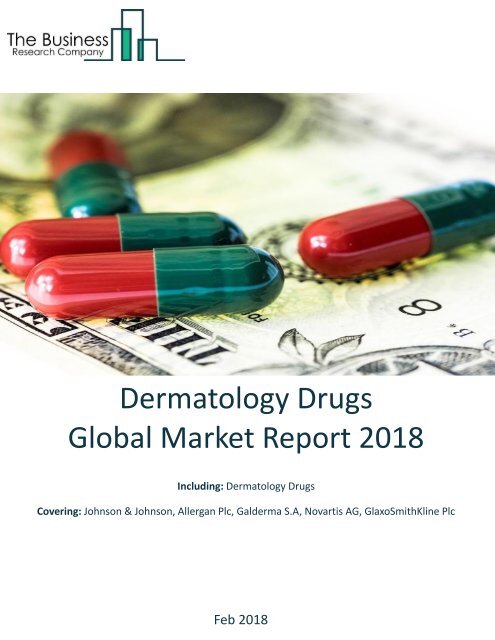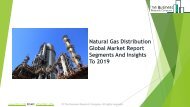Dermatology Drugs Global Market Report 2018
North America was the largest region in the dermatology drugs market in 2017, accounting for around 31% market share. The USA was the largest country in the market in 2017, accounting for over 24% market share. Read Report https://www.thebusinessresearchcompany.com/report/dermatology-drugs-global-market-report-2018
North America was the largest region in the dermatology drugs market in 2017, accounting for around 31% market share. The USA was the largest country in the market in 2017, accounting for over 24% market share.
Read Report
https://www.thebusinessresearchcompany.com/report/dermatology-drugs-global-market-report-2018
You also want an ePaper? Increase the reach of your titles
YUMPU automatically turns print PDFs into web optimized ePapers that Google loves.
<strong>Dermatology</strong> <strong>Drugs</strong><br />
<strong>Global</strong> <strong>Market</strong> <strong>Report</strong> <strong>2018</strong><br />
Including: <strong>Dermatology</strong> <strong>Drugs</strong><br />
Covering: Johnson & Johnson, Allergan Plc, Galderma S.A, Novartis AG, GlaxoSmithKline Plc<br />
Feb <strong>2018</strong>
Reasons to Purchase<br />
• Outperform competitors using accurate up to date demand-side dynamics<br />
information.<br />
• Identify growth segments for investment.<br />
• Facilitate decision making on the basis of historic and forecast data and the<br />
drivers and restraints on the market.<br />
• Create regional and country strategies on the basis of local data and analysis.<br />
• Stay abreast of the latest customer and market research findings<br />
• Benchmark performance against key competitors.<br />
• Develop strategies based on likely future developments.<br />
• Utilize the relationships between key data sets for superior strategizing.<br />
• Suitable for supporting your internal and external presentations with reliable high<br />
quality data and analysis<br />
• Gain a global perspective on the development of the market.<br />
• <strong>Report</strong> will be updated with the latest data and delivered to you within 3-5<br />
working days of order.<br />
Scope<br />
<strong>Market</strong>s Covered: <strong>Dermatology</strong> <strong>Drugs</strong><br />
Companies Mentioned: Johnson & Johnson, Allergan Plc, Galderma S.A, Novartis AG,<br />
GlaxoSmithKline Plc<br />
Countries: Brazil, China, France, Germany, India, Italy, Japan, Spain, Russia, UK, USA and<br />
Australia.<br />
Regions: Asia-Pacific, Western Europe, Eastern Europe, North America, South America,<br />
Middle East And Africa<br />
Time series: Five years historic and forecast.<br />
Data: Ratios of market size and growth to related markets, GDP, Expenditure Per Capita,<br />
<strong>Dermatology</strong> <strong>Drugs</strong> Indicators Comparison.<br />
Data segmentations: Country and regional historic and forecast data, market share of<br />
competitors, market segments.<br />
Sourcing and Referencing: Data and analysis throughout the report is sourced using end<br />
notes.
<strong>Dermatology</strong> <strong>Drugs</strong> <strong>Market</strong><br />
Characteristics<br />
The dermatology drugs market includes medications that are used for the<br />
treatment of skin conditions such as dermatitis (including eczema), rosacea,<br />
hyperhidrosis, androgenic alopecia, onychomycosis, hair loss, acne, immune<br />
disorders (including psoriasis), microbial infections (bacterial, fungal, and viral),<br />
vascular and pigmented lesion removal, common warts, seborrheic keratosis, and<br />
other skin diseases The market numbers within this briefing are restricted to<br />
pharmaceutical (drug) treatments and do not cover biologic treatments for these<br />
conditions which are included in a separate briefing.<br />
<strong>Dermatology</strong> drugs used to treat acne include local anesthetics, cleansers, antiinflammatory<br />
agents, anti-infectives, emollients, and astringents. These drugs are<br />
available for both topical (external) use and internal use. These drugs can be sold<br />
as over-the-counter (OTC) as well as prescription drugs. Major OTC dermatological<br />
drugs include Differin, Lamisil, Monistat, and Abreva. Some of the major<br />
dermatology prescription drugs include Clobetasol propionate, Flucinonide,<br />
Baxdela, Siliq, Rhofade.<br />
The segments that are covered include –<br />
<strong>Dermatology</strong> <strong>Drugs</strong> –<br />
Topical dermatology drugs are available in a wide range of<br />
In this report market value is defined as the revenues organizations earn by selling<br />
their goods and services within the specified market, based on the price at which<br />
they sell. Only goods and services traded between entities are included.<br />
The revenues for a specified geography are consumption values – that is, they are<br />
revenues generated by organizations in the specified geography within the<br />
specified market, irrespective of where they are produced.
<strong>Dermatology</strong> <strong>Drugs</strong> <strong>Market</strong><br />
Historic Growth<br />
The global dermatology drugs market grew from $X billion in 2013 to $X billion in<br />
2017 at a compound annual growth rate (CAGR) of X%.<br />
The chart and table below shows the year-on-year growth of the global<br />
dermatology drugs market during 2013 – 2017.<br />
Drivers of the <strong>Market</strong>:<br />
Restraints on the <strong>Market</strong>:
<strong>Dermatology</strong> <strong>Drugs</strong> <strong>Market</strong><br />
Forecast Growth<br />
The global dermatology drugs market is expected to grow from $XX billion in 2017<br />
to $40 billion in 2021 at a compound annual growth rate (CAGR) of XX%. Going<br />
forward, increase in the number of indications treated by topical drugs coupled<br />
with increase in acne and rosacea patients will drive the market for dermatology<br />
drugs.<br />
The chart and table below shows the year-on-year growth of the global<br />
dermatology drugs market during 2017 - 2021.<br />
Drivers of the <strong>Market</strong>:<br />
Restraints on the <strong>Market</strong>:
<strong>Dermatology</strong> <strong>Drugs</strong> <strong>Market</strong><br />
Regional And Country Analysis<br />
The Asia Pacific was the largest region in the dermatology drugs market in 2017,<br />
dermatology drugs for $X billion or 38% market share.<br />
North America was the x largest region dermatology drugs for $X billion or X%<br />
market share.<br />
Western Europe was the x largest region dermatology drugs for $X billion or X%<br />
market share.
<strong>Dermatology</strong> <strong>Drugs</strong> <strong>Market</strong><br />
Competitive Landscape<br />
The leading competitors in the global dermatology drugs market are Johnson &<br />
Johnson, Allergan Plc, Galderma S.A., Novartis AG, GlaxoSmithKline Plc.<br />
The chart and table below displays the percentage market share of the top players<br />
in the dermatology drugs market industry.<br />
Johnson & Johnson generated revenues of $XX billion for the financial year 2016,<br />
an XX% increase from the previous year.<br />
Allergan Plc. generated revenues of $XX billion for the financial year 2016, an XX%<br />
increase from the previous year.<br />
Galderma S.A. generated revenues of $XX billion for the financial year 2016, an<br />
XX% increase from the previous year.
Novartis AG generated revenues of $XX billion for the financial year 2016, an XX%<br />
increase from the previous year.<br />
GlaxoSmithKline Plc. generated revenues of $XX billion for the financial year 2016,<br />
an XX% increase from the previous year.<br />
Bayer AG generated revenues of $XX billion for the financial year 2016, an XX%<br />
decrease from the previous year.<br />
LEO Pharma A/S generated revenues of $XX billion for the financial year 2016, an<br />
XX% increase from the previous year.<br />
Company Profile<br />
Johnson & Johnson<br />
Overview<br />
Johnson & Johnson (J&J) was the largest competitor in the dermatology<br />
drugs market in 2017 with a XX% share of the market. The company is<br />
engaged in the development, manufacturing and marketing of personal care<br />
hygienic products, pharmaceuticals and surgical equipment. J&J was<br />
founded in 1886 and is headquartered at New Jersey, USA.<br />
Products and Services<br />
J&J operates through the following business divisions –<br />
The Consumer division offers<br />
The Pharmaceutical division offers products in<br />
The Medical Devices And Diagnostics division manufactures products used<br />
by<br />
Strategy<br />
Johnson & Johnson aims to grow its geographic footprint and increase<br />
investments in emerging markets and developed markets such as Japan. In<br />
2016, the company spent $9.1 billion in R&D.liv With prioritized<br />
investments in internal R&D, strategic licensing arrangements, partnerships<br />
and select acquisitions, the company intends to build a robust product<br />
pipeline for
Financial Performance<br />
Johnson & Johnson’s Beauty section in Consumer division, involved in<br />
dermatology drugs manufacturing, generated revenues of $3.9 billion for the<br />
financial year 2016, a 7.3% increase from the previous year. The company<br />
had market<br />
Allergan Plc<br />
Overview<br />
Products and Services<br />
Strategy<br />
Financial Performance<br />
Galderma S.A<br />
Overview<br />
Products and Services<br />
Strategy<br />
Financial Performance<br />
Novartis AG<br />
Overview<br />
Products and Services<br />
Strategy<br />
Financial Performance<br />
GlaxoSmithKline Plc<br />
Overview<br />
Products and Services<br />
Strategy<br />
Financial Performance

















